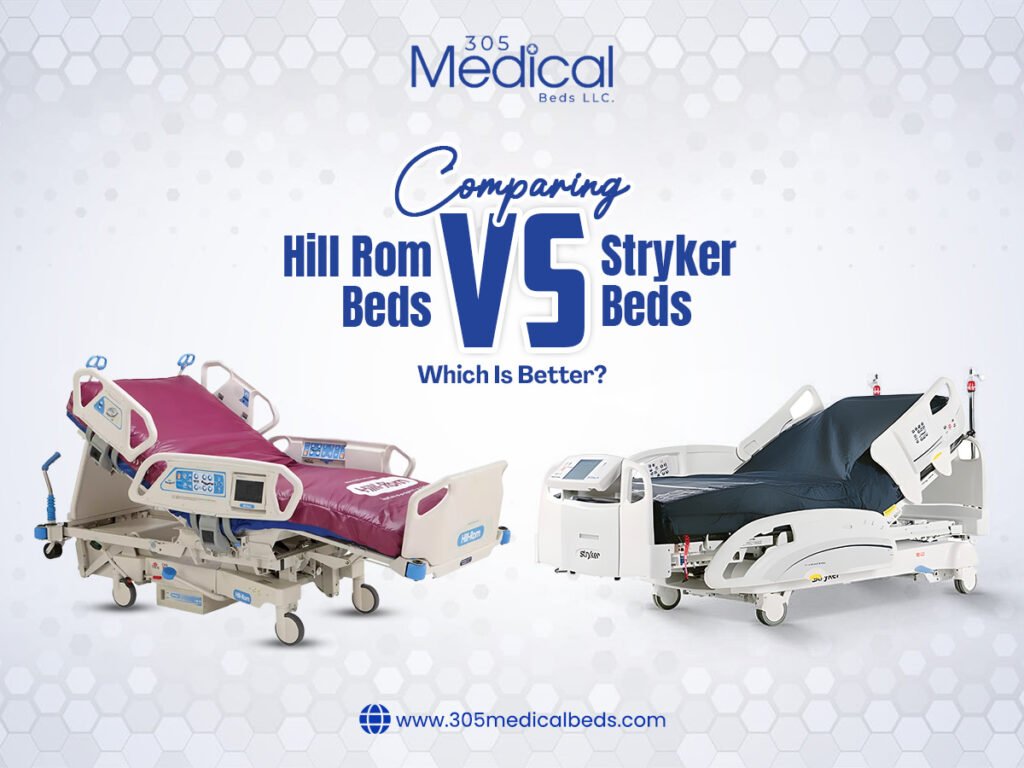
When it comes to patient care, the right hospital bed can make all the difference in comfort, safety, and recovery. Whether you’re equipping a hospital, clinic, or home care setup, two brands dominate the market: Hill-Rom beds and Stryker beds. Both are known for durability, advanced features, and patient comfort—but which is the right choice for your needs?
In this comprehensive guide, we’ll break down Hill-Rom vs. Stryker beds, comparing features, safety, comfort, mattress compatibility, price, and caregiver convenience. By the end, you’ll have a clear understanding of which bed fits your care requirements.
Overview of Hill-Rom Beds
Hill-Rom has been a trusted name in hospital beds for decades. Known for innovation, safety, and patient comfort, Hill-Rom beds are used widely in ICUs, long-term care facilities, and home care.
Key Features
- Advanced Pressure Relief: Many Hill-Rom models integrate low-air-loss mattresses and alternating pressure systems to prevent bedsores.
- Adjustable Positions: Electronic controls for head, foot, and overall tilt adjustments.
- Patient Safety: Includes side rails, fall-prevention technology, and optional bed exit alarms.
- Caregiver Convenience: Programmable positions, ergonomic controls, and smooth mobility reduce caregiver strain.
Pros
- Reliable and durable for long-term use.
- Compatible with air mattresses for hospital beds and memory foam hospital bed mattresses.
- Smooth, quiet operation enhances patient comfort.
Cons
- Higher initial cost compared to competitors.
- Advanced models may require professional installation.
Overview of Stryker Beds
Stryker beds are designed for versatility, ergonomic use, and patient safety. They are popular in hospitals, surgical units, and home care settings.
Key Features
- Advanced Mobility: Designed for smooth transport and emergency maneuvering.
- Pressure Management: Compatible with air pressure mattresses and foam mattresses for hospital beds.
- Adjustable Positions: Electric controls for head, foot, Trendelenburg, and semi-Fowler positions.
- Patient Safety: Side rails, optional fall-prevention alarms, and stable frame design.
Pros
- Durable and suitable for both hospital and home care.
- Ergonomic design for both patients and caregivers.
- Wide compatibility with mattresses and medical accessories.
Cons
- Some advanced features cost extra.
- Fewer built-in specialized pressure relief systems compared to Hill-Rom.
Hill-Rom vs. Stryker Beds: Feature Comparison
| Feature | Hill-Rom Beds | Stryker Beds |
|---|---|---|
| Patient Comfort | Advanced pressure relief, low air loss options | Compatible with air or foam mattresses, good pressure management |
| Adjustability | Electric controls, Trendelenburg, and more | Electric controls, Trendelenburg, semi-Fowler, and more |
| Safety | Side rails, fall-prevention, bed exit alarms | Side rails, fall-prevention, optional bed exit alarms |
| Caregiver Ease | Ergonomic, programmable positions, mobility | Ergonomic design, smooth maneuverability |
| Durability | High | High |
| Price | Higher | Moderate to high |
| Maintenance | Professional setup recommended for advanced features | Easier setup, fewer advanced built-ins |
This table can help you match your patient needs and budget with the features that matter most.
Mattress Compatibility
Patient comfort depends heavily on mattress choice. Both Hill-Rom and Stryker beds support:
- Foam Mattresses: Great for moderate-risk patients.
Examples: hospital bed foam mattress, memory foam mattress for hospital bed - Air Mattresses: Ideal for high-risk or immobile patients.
Examples: air mattress for hospital bed, low air loss mattress for hospital bed, adjustable air mattress for hospital beds
Who Should Choose Hill-Rom Beds?
- Hospitals require advanced pressure relief beds.
- Care settings that prioritize built-in safety features and quiet operation.
- Facilities are looking for programmable positions and ergonomic caregiver support.
Who Should Choose Stryker Beds?
- Caregivers need durable, versatile beds.
- Patients who require flexible mattress options, including foam or air mattresses.
- Settings that benefit from easy mobility and ergonomic controls.
Cost Considerations
- Hill-Rom Beds: Higher upfront cost, but includes integrated advanced features.
- Stryker Beds: Moderate to high price; external accessories may be added as needed.
Tip: Pairing refurbished beds from 305 Medical Beds with compatible mattresses can save money without sacrificing comfort.
Long-Term Maintenance
- Regular Cleaning: Use hospital-approved disinfectants for hygiene.
- Inspect Mechanisms: Test electrical controls and bed mobility functions regularly.
- Check Mattresses: Rotate foam or adjust air pressure in air mattresses to maintain comfort.
- Caregiver Training: Ensure proper use of bed functions and mattress adjustments.
Hospital Bed Accessories
Accessories enhance both patient comfort and caregiver efficiency:
- Trapeze Bars: Assist patients with repositioning.
- IV Poles: Attach easily to hospital beds for fluid administration.
- Over-Bed Tables: Improve patient independence and convenience.
- Mattress Protectors: Protect mattresses and increase hygiene.
Conclusion: Hill-Rom vs. Stryker Beds
Choosing between Hill-Rom and Stryker beds depends on your patient’s needs, budget, and care environment:
- Hill-Rom Beds: Best for high-risk patients requiring advanced pressure relief and built-in safety features.
- Stryker Beds: Ideal for versatile, durable, ergonomic beds with mattress compatibility and caregiver convenience.
Pair either brand with a high-quality foam or air mattress for hospital beds to maximize patient comfort and support.
Combining Comfort with Refurbished Beds
At 305 Medical Beds, our refurbished Hill-Rom and Stryker beds provide:
- Cost-effective, high-quality hospital beds
- Compatibility with foam and air mattresses
- Adjustable features for patient comfort
- Easy delivery and setup for home or facility care
Frequently Asked Questions
Q1: Which bed is better for preventing pressure sores?
A: Hill-Rom beds often feature integrated low-air-loss or alternating-pressure systems. Stryker beds support external air mattresses for pressure relief.
Q2: Can I use these beds at home?
A: Yes, both Hill-Rom and Stryker beds are compatible with home care setups, especially when purchased as refurbished hospital beds from 305 Medical Beds.
Q3: Are these beds compatible with all hospital mattresses?
A: Yes. Both brands support foam mattresses, air mattresses, and low-air-loss mattresses.
Q4: Which is more affordable?
A: Stryker beds are generally more cost-effective upfront, while Hill-Rom beds offer more built-in features.
Q5: Are there bariatric options?
A: Yes, both brands offer bariatric beds designed for higher weight capacities.





